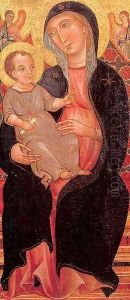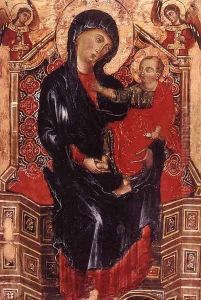Deodato Orlandi Paintings
Deodato Orlandi is an artist about whom very little is known, including his exact birth and death dates. He is believed to have been active during the late 13th and early 14th centuries, a time during which the art world in Italy was undergoing significant changes with the transition from Byzantine to Gothic styles, and the early seeds of the Renaissance were being planted. Orlandi was likely from Lucca, a city in Tuscany, Italy, which was an important center for the arts and culture during the medieval period.
Despite the scarcity of personal details, Orlandi’s work has been associated with the development of Italian panel painting. He has been credited with the 'Pistoia Santa Trinita Maestà,' an altarpiece for the church of Santa Trinita in Pistoia, which has been dated to around 1301. This work exemplifies the blending of Byzantine iconography with the emerging Gothic style, characteristic of that transitional period in Italian art.
Orlandi's figures often display a certain stiffness and adherence to the Byzantine tradition, yet with an increased sense of three-dimensionality and a gentle attempt at rendering the human form with more naturalism, which would be fully realized in the later works of artists like Giotto. Unfortunately, because of the limited number of works confidently attributed to him and the general lack of documentation, Deodato Orlandi remains a somewhat obscure figure in art history. His contributions, however, are still recognized as part of the collective progression towards the Renaissance that would define the succeeding centuries of European art.

